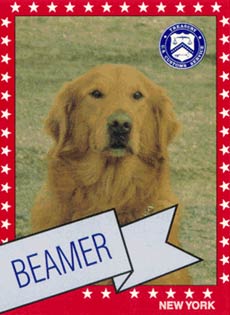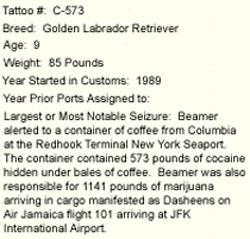Canine Cops

Taking a Bite Out of Crime
| Send this Page to a Friend! |
 |
How long has the Customs Service been using dogs to search for dangerous drugs?
Detector dogs were introduced on a wide scale in September 1970 as part of a major effort to interdict narcotics being smuggled through major air/sea and land border ports.
How are detector dogs used?
Teams consisting of a dog and officer are used to screen arriving aircraft, cargo, baggage, mail, ships, vehicles, and passengers.
What kinds of dogs are used for this work?
Customs uses a wide variety of dogs including Labrador retrievers, golden retrievers, German Shepherds, Brittany spaniels, German short-hair pointers, and mixed breeds. Dogs used by Customs can be of either sex and must be between 1 and 3 years of age.
How does Customs obtain its dogs?
Dogs that are selected for training are obtained from animal shelters and rescue leagues, primarily in the eastern and Midwestern part of the United States. Many of these dogs are unadoptable and would have to be destroyed. Dogs, meeting the entrance qualifications, are also taken as donations from private owners. Some dogs are purchased through contract vendors. Recently, U. S. Customs, in association with Australian Customs, began a breeding program to provide additional detector dogs. As the U.S. Customs detector dog program grows, we continue to look for new ways to recruit dogs.
 |
Where are the dogs trained?
All Customs dogs are trained at the Canine Enforcement Training Center in Front Royal, Virginia, approximately 70 miles west of Washington, D.C.
What are the dogs taught to find?
The dogs are taught to detect concealed narcotics, such as heroin, cocaine, and marijuana, and other dangerous drugs. Some dogs are even taught to detect currency. The officers are instructed in Customs law, firearms, and reading the "alert" of their dogs to the areas where narcotics are hidden. The dogs and officers are trained by Customs Canine Enforcement Officers with professional experience in this field.
What is the typical workday for a canine enforcement team?
Canine enforcement teams work a full 8-hour day. Teams assigned to airports and seaports alternate between examining aircraft, vessels, baggage, cargo, and mail. Teams stationed at land border crossings devote their time to examining vehicles and merchandise entering the United States.
How do dogs compare with people in examining vehicles, cargo, or mail?
At border ports a dog can examine a vehicle in 5 to 6 minutes. Even a cursory search by a Customs inspector would require at least 20 minutes. Dogs can check packages in a fraction of the time needed by Customs mail examiners. A canine team can process 400 to 500 packages in about 30 minutes.
How many years does Customs keep dogs on the job? What happens after they retire?
Customs employs dogs as long as they can successfully perform and meet workload requirements. Upon retirement, the dogs are usually adopted by their handlers or a good home is found for the animal.
How successful are the dogs?
From October 1998 through September 1999, U.S. Customs Canine Enforcement Teams were involved in over 11,000 narcotic or currency related seizures. The street value of the narcotics uncovered by the canines exceeded several billion dollars. The dogs detected approximately 631,909 pounds of marijuana, 50,748 pounds of cocaine, 358 pounds of heroin, and $25.5 million in currency.
What is the case history of a detector dog?
One of the more interesting "alerts" was by a canine named Taylor. This led to the discovery of 43 pounds of heroin inside the gas tank of a vehicle arriving at the Port of San Ysidro, California. In another interesting discovery, a canine named Pepper, at the Port of Newark, New Jersey, indicated to inspectors that the roof of a sea container need a closer look. The roof was found to contain more than 1,000 pounds of cocaine
| ENFORCEMENT ACTIVITY | ENFORCEMENT RESULTS | FY 1998 | FY 1999 |
|---|---|---|
| Total Number of Persons, Packages, and Vehicles Searched | 204 Million | 224 Million |
| Total Number of Drug and Currency Detections | 10,700 | 11,000 |
| Number of Resulting Arrests | 6,800 | 7,900 |
| Marijuana Discovered | 576,511 Lbs. | 631,909 Lbs. |
| Cocaine Discovered | 54,008 Lbs. | 50,748 Lbs. |
| Heroin Discovered | 316 Lbs. | 358 Lbs. |
| Hashish Discovered | 626 Lbs. | 789 Lbs. |
| Currency Discovered | $27.8 Million | $25.5 Million |
Source: U.S. Customs Service
